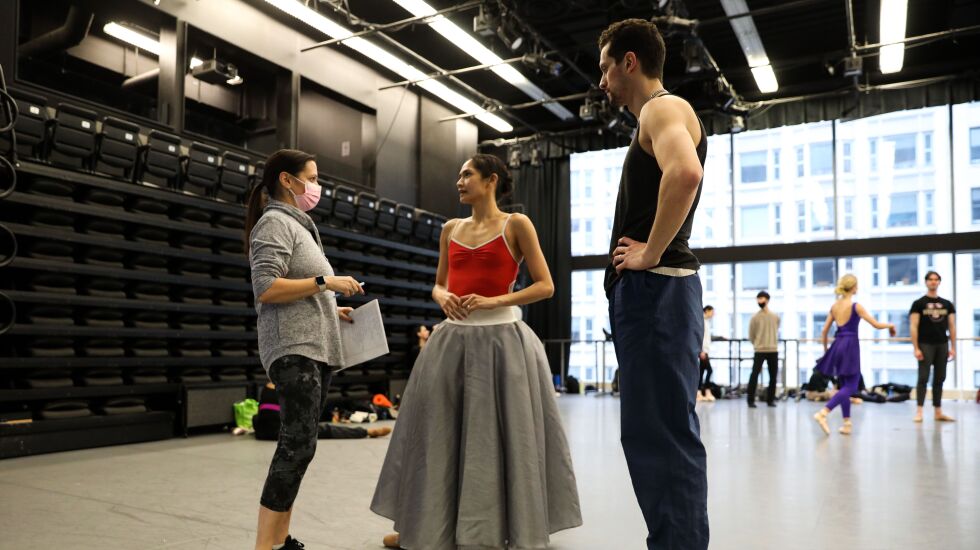
Plays have scripts that tell actors what to say, plus occasional stage directions, indicating how to deliver a certain line or when to move in a particular direction — the most famous being Shakespeare’s notation in Act III of “A Winter’s Tale”: “Exit, pursued by a bear.”
Music has chains of notes representing various pitches and durations, with extra instructions delineating whether they be played loud or soft, fast or slow.
But how do ballet dancers know where to step?
There are videos, of course, and a complex system known as Benesh Movement Notation, resembling notes on a scale. Neither works particularly well.
“I can tell when someone learned off an audition video,” said Suzanne Lopez, one of two choreography directors from the Joffrey Ballet for “Anna Karenina,” opening at the Civic Opera House on Wednesday. As for the notation system, “It takes years of learning how to do that,” she said, “and I’m not qualified.”
So how does a troupe learn a new ballet? Surprisingly, the way dancers are taught their steps in the 21st century has much in common with the way bards were taught to recite “The Iliad” in ancient Greece.
“It needs to be person-to-person,” said Lopez. “It needs to be passed down. Copious notes. I have a giant binder for ‘Anna Karenina,’ constantly updating.”
Which can be a challenge when working with a top choreographer like Yuri Possokhov, the former star dancer with the Bolshoi Ballet and frequent guest choreographer at the Joffrey.
Possokhov starts creating a ballet choreography to only one or two dancers.
“He wants to have that small, intimate feeling when he’s creating,” Lopez said.
Rehearsals are collaborations.
“He doesn’t come into the room with the choreography already made up,” she said. “He’ll listen to the music, he’ll create some movement, and our job is to flesh that out.”
Not that it’s easy.
“When things are described, it sounds like something that can’t possibly be done,” Lopez said. “It just sounds impossible. ‘Throw her this way and she’ll land that way.’ We can’t picture it at all. Then he will do it, himself, with a partner, whoever was in the room, and make it work.”
Part of it is listening to the dancers.
“He has a little more of a collaborative process than other people. He really wants the dancer to bring their individual personalities to the movement,” she said. “He couldn’t do it alone and really doesn’t want to. For the dancers, it’s a lovely process and gives them a feeling of ownership to the material.”
Speaking of owning the material, the Joffrey is being assailed on social media for putting on the ballet of a Russian novel.
“It looks like you’ve been living under a rock for the past year, but at least try to read the room,” runs a typical comment. “Russia has blood of innocent people on its hands, including dancers. This is a shame to promote their culture at this time.”
Punishing members of an artistic community for the crimes of autocratic leaders half a world away is not fighting fascism, but manifesting it. It might feel like doing something for social media warriors, but often hurts the wrong people: Possokhov, for starters, is Ukrainian.
This is especially questionable in Chicago, the city where, during World War I, schools stopped teaching German, and our City Council purged streets of Germanic names like Berlin, Hamburg and Rhine. That is not the sort of zeal a city looks back on with pride. Even then, “Goethe” was spared because his contributions to world culture were seen as surpassing his unfortunate heritage.
That has to go double for Tolstoy, a strict pacifist who urged his followers to avoid military service. “Anna Karenina” doesn’t boost Russian aggression today, but denounces their war, all war, as “a beastly, cruel, and awful thing.”
Besides, these collaborations take many years. The Joffrey asked Possokhov to create “Anna Karenina” in 2014. That involved commissioning an original score and working with the Australian Ballet. The ballet debuted in Chicago in 2019. To bring this international, five-year artistic effort to a screeching halt would harm not Vladimir Putin, but ourselves. We need arts now more than ever, particularly ballet, especially this one.
“Love those who hate you.” Tolstoy writes in “Anna Karenina,” bearing in mind that “when you love someone, you love the whole person, just as he or she is, and not as you would like them to be.”
“Anna Karenina” runs through Feb. 26.







